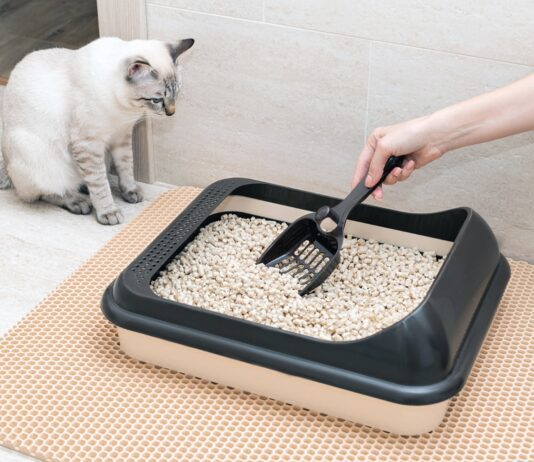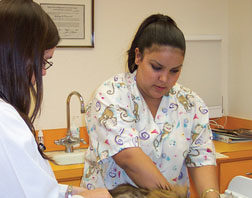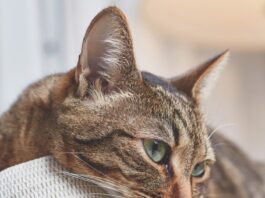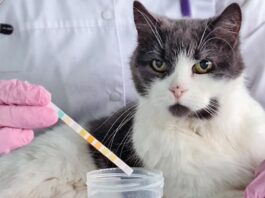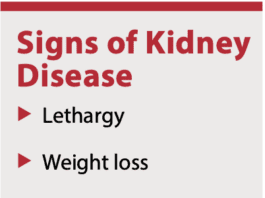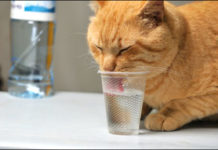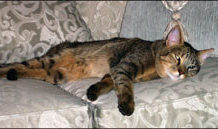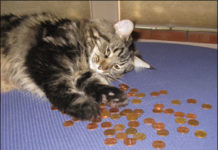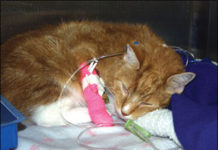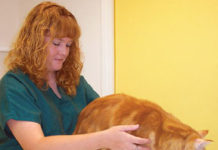A Study of Stem Cells to Improve Kidney Function
A clinical trial under way at Colorado State University is using stem cells to treat cats with late-stage chronic kidney disease (CKD). “There’s a lot of hype around stem cells right now,” says lead researcher Stephen Dow, DVM, Ph.D. “Unfortunately, a lot of the claims are unsubstantiated. We hope to show whether the cells make a difference in cats with CKD.” The researchers want to determine if the injection of stem cells in 20 cats will improve kidney function, reduce side effects such as inflammation and fibrosis, and delay the disease’s progression.
Kittens and the Aging Are Vulnerable
When a kitten or elderly cat shows little interest in food, loses weight, develops a persistent fever and succumbs to an untimely death, too many heartbroken owners are left to wonder: What was the cause of death?
Trial uses stem cells to treat kidney Disease
Researchers at Colorado State University College of Veterinary Medicine are testing a new treatment for a common problem in aging cats. They’re using stem cells in an effort to better manage chronic kidney disease. “In our clinical trial, we are seeing if stem cells can improve renal function, decrease inflammation and scarring in the kidney, and improve levels of excess protein in the urine,” says Jessica Quimby, DVM, who’s working with a team of team of veterinarians and researchers at the school.
Short Takes: June 2012
Owners often bring their cats to the veterinarian due to a bout of constipation, which can have a variety of causes. Veterinary treatment includes determining and eliminating the cause, if possible, along with medical and sometimes surgical management. Medical therapy often includes the use of laxatives, enemas and prokinetic agents (like cisapride). Psyllium is a soluble fiber that produces a mucilaginous gel that helps to increase fecal bulk. It also adds to stool bulk by other water-holding properties. Psyllium has been found to increase stool frequency and consistency in humans with idiopathic constipation.
Short Takes: October 2011
Cytauxzoonosis — often a fatal infection in domestic cats — is a disease caused by the parasite Cytauxzoon felis, which is transmitted by the bite of a tick. Most affected cats are young adults with exposure to the outdoors and vague clinical signs of lethargy and anorexia. Treatment for cytauxzoonosis is usually imidocarb diproprionate, but a combination of atovaquone and azithromycin (A&A) has also been utilized as a treatment. (neither form of therapy has been prospectively evaluated for efficacy, however). Eighty acutely ill cats with Cytauxzoon felis infection were treated at various veterinary clinics. Of 53 cats treated with A&A, 32 (60 percent) survived to discharge.
Understanding Feline Kidney Failure
Unfortunately, our beloved cats can face many ailments that develop as they age. Chronic renal disease is among the more serious of age-related conditions. It affects many older cats, but acute renal failure can be caused by other factors such as eating or drinking toxins, or kidney infection.
Diagnosis: Kidney Disease
Your cats kidneys play a central role in almost all of its bodily processes. They help to control the blood pressure and regulate the amount and chemical consistency of fluid in the bloodstream. They produce a variety of vitally needed hormones and enzymes, and they contribute to the production of red blood cells. They also remove metabolic waste, such as urea, mineral salts and poisonous substances, from its blood. This is accomplished by kidney (renal) tissue containing hundreds of thousands of tiny filtration units called nephrons. When waste-laden blood enters the kidneys through the renal artery, it moves through progressively smaller vessels until it reaches these nephrons, where it is filtered through microscopically minute structures called glomeruli. The cleansed blood about 95 percent of the total fluid volume that originally entered the kidneys then circulates back to the heart for yet another voyage through the body. Meanwhile, the remaining fluid, containing the waste products, is passed along as urine from the kidneys to the bladder and eventually excreted.
Short Takes: 04/09
What once was termed "renal failure" is now called feline chronic kidney disease (CKD), in part because the word "failure" sounded too terminal: Many cats live on for years (with treatment) with chronic kidney disease. One such survivor was the first ShortTakes office manager, the late, great Gertie. That stalwart kitty was diagnosed with renal failure in "middle age," around 11 years old. She hung on to see her 20th birthday - a little shaky toward the end - but mostly thriving with good "quality of life" thanks to expert veterinary care, therapeutic renal diets, blood pressure medicine for her hypertension, and plenty of fresh water for the thirst that goes along with kidney disease.
Ask Elizabeth: 07/08
My kitten, Snapper, recently spent a week in intensive care. Hes fine now, but he was so very sick that we feared he wouldnt make it. The cause of all his troubles turned out to be a penny. Yes, a penny! Apparently he had eaten one. As we later learned, pennies minted after 1982 are made from zinc, with just a coating of copper. If an animal swallows one, stomach acids eat away the copper…
Feline Kidneys: Vulnerable
Your cats kidneys, two relatively small organs located behind its rib cage - one on each side of its spine - play a central role in almost all of its bodily processes. They help to control the blood pressure and regulate the amount and chemical consistency of fluid in the bloodstream. They produce a variety of vitally needed hormones and enzymes, and they contribute to the production of red blood cells.
Short Takes: 06/07
It hardly seems possible. But time flies, and what was once a rare procedure - kidney transplants for cats with renal failure - is now performed often enough that researchers can look at a relatively unusual complication of a once-rare operation. And they can give it a name: PTDM, or post-transplantation diabetes mellitus, as veterinary scientists from the University of California-Davis and the University of Pennsylvania did in the Journal of the American Veterinary Medical Association (Vol. 230, No. 6).
Diagnosis: Kidney Disease
Your cats kidneys play a central role in almost all of its bodily processes. They help to control the blood pressure and regulate the amount and chemical consistency of fluid in the bloodstream. They produce a variety of vitally needed hormones and enzymes, and they contribute to the production of red blood cells. They also remove metabolic waste, such as urea, mineral salts and poisonous substances, from its blood. This is accomplished by kidney (renal) tissue containing hundreds of thousands of tiny filtration units called nephrons. When waste-laden blood enters the kidneys through the renal artery, it moves through progressively smaller vessels until it reaches these nephrons, where it is filtered through microscopically minute structures called glomeruli. The cleansed blood - about 95 percent of the total fluid volume that originally entered the kidneys - then circulates back to the heart for yet another voyage through the body. Meanwhile, the remaining fluid, containing the waste products, is passed along as urine from the kidneys to the bladder and eventually excreted.

